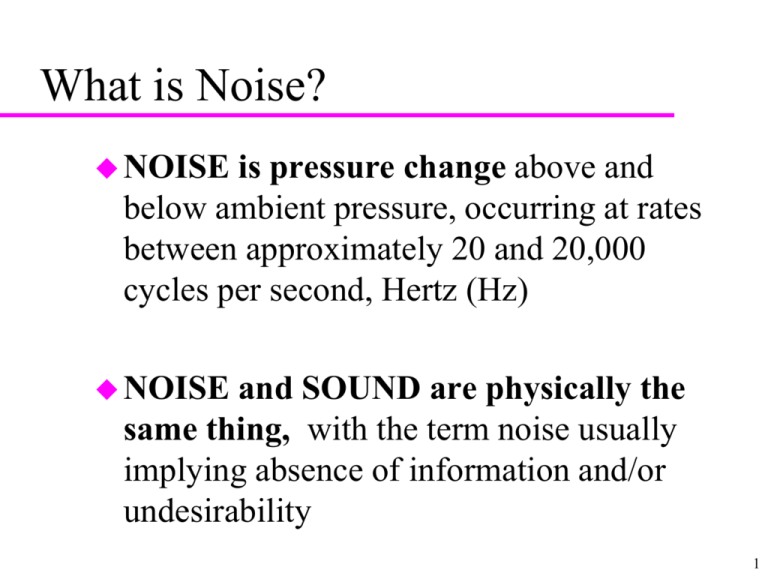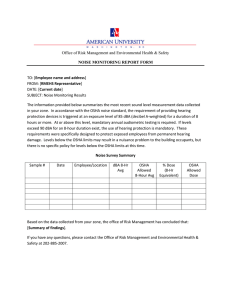Noise Review
advertisement

What is Noise? NOISE is pressure change above and below ambient pressure, occurring at rates between approximately 20 and 20,000 cycles per second, Hertz (Hz) NOISE and SOUND are physically the same thing, with the term noise usually implying absence of information and/or undesirability 1 2 3 4 5 Representation of Pressure Waves Dr. Dan Russell, http://www.gmi.edu/~drussell/Demos/rad2/mdq.html 6 Frequency, Amplitude, and Wavelength of a Sound Wave SOUND WAVE AMPLITUDE Peak RMS 0.5 0.0 Atmospheric Pressure -0.5 -1.0 C l= f DISTANCE (one wavelength) velocity C=f• 344 m/sec @ 72 F 7 8 9 Acoustic Quantities Pressure, P (P2 energy, power) Pressure amplitude measured in N/m 2 , Pascals 2 (48 Pascals = 1 lb/ft ) atmospheric pressure 10 Pascals 5 faintest audible sound 2 10 Pascals -5 loudest tolerable sound 28-30 Pascals 10 Decibels – a Useful Transformation 11 Sound Pressure Level (SPL) Use of deciBels deciBels, dB, is a useful transformation because it permits compressing one unit that may cover a huge range into a smaller numerical range note that a few dB is a large change in the original unit useful for sound Intensity, Power, Pressure 13 SPL vs. Sound Pressure Sound pressure level (dB) Pneumatic chipper (at 5 ft) Textile loom Newspaper press Diesel truck 40 mph (at 50 ft) Sound pressure (Pa) 120 110 100 90 80 70 Passenger car 50 mph (at 50 ft) Conversation (at 3 ft) Copy machine (at 2 m) Quiet room Air conditioning in auditorium Quiet natural area with no wind Anechoic chamber 60 50 40 20 10 5 Rock band 2 1 0.5 Power lawnmower (at operator’s ear) 0.2 0.1 0.05 Garbage disposal (at 3 ft) Milling machine (at 4 ft) Vacuum cleaner 0.02 Air conditioning window unit (at 25 ft) 0.01 0.005 10 0.002 Suburban area at night 0.001 0.0005 0.0002 0.0001 0.00005 0 0.00002 30 20 14 deciBel addition (by table) difference in dB: add to higher: 0 3.0 1 2.6 2 2.2 3 1.8 4 1.4 5 1.2 6 1.0 7 0.8 8 .6 9 .5 10 .4 11 .3 13 .2 16 .1 15 deciBel addition (by table) it is customary to rank order the dB values to be added from largest to smallest for the largest two, find the difference, enter the table in col.1, find value in col.2, and add to largest of the pair being added add the result of the first pair addition to the third value, get a new total add the new total to the 4th largest value, get new total,etc. 16 deciBel Addition (by table) 17 Frequency Spectrum & Octaves acoustic energy covers a range of frequencies, and in varying intensity customary to divide the frequency spectrum into octaves, half-octaves, or third-octaves for measurment and hearing testing An octave is a range such that the top frequency is twice the bottom frequency octaves are identified by center frequencies: 31.5, 63, 125, 250, 500, 1k, 2k, 4k, 8k, 16k Hz 18 Loudness and Weighting Scales the ear does not hear all frequencies with equal response for equal energy the low frequencies do not sound as loud, generally numerical measures at various overall noise levels of the apparent loudness relative to that at 1000 Hz are Weighting Scales 19 Weighting Scales the weighting scale for overall sound-level of approx. 55 dB is the A-weighting Frequency 20 Weighting Scales because the A-weighting was thought to approximate the ear’s sensitivity, and: because A-weighted noise measurements fit the hearing-loss data of the 1950’s and 1960’s reasonably well: ANSI, ACGIH, and subsequently OSHA all specified that SPL’s should be measured Aweighted (and slow response), dBA 21 Sound Measurement Equipment noise (sound pressure level) meters dosimeters octave band analyzers sound intensity meters real time or spectrum analyzers impact meters vibration meters 22 Noise Surveys Source measurements Surveys – Area measurements – Workstation measurements – Personal Dosimetry 23 OSHA Noise Rules time allowed 8 4 2 1 0.5 0.25 0.125 sound level, dBA 90 5 dB 95 100 105 110 115 120 24 OSHA Noise Rules (continued) the OSHA criterion of 90 dBA for 8 hours was thought to prevent most hearing loss the 5 dB exchange rate, i.e. time is cut in half if SPL increases 5 dB, was a simplification of more complex data, and assumes that the noise experienced is interrupted several times per day 25 Noise Dose each line in the OSHA table represents ALL the allowed noise above 90 dB for a whole 8-hour day, i.e. 100% of the allowed noise dose if people experience varying levels, dose is calculated as: C1 C 2 Cn %Dose = 100 Tn T1 T2 where C i = time experienced at a given level and Ti = time allowed at the given level Threshold Limit Value(R) - Noise Sound level TLV time allowed 85 dBA 8 hours 88 4 91 2 94 1 97 0.5 100 0.25 103 0.125 (OSHA) 16 hrs. 10.6 7 4.6 3 2 1.3 Threshold Limit Value - Noise note that the TLV not only assigns the 8-hour allowed level to 85 dBA, but that the exchange rate is 3 dB, i.e. time is halved if the level goes up 3 dB this means that a given noise exposure scenario will have a higher dose than under OSHA rules, and that the calculated Leq will be different OSHA Hearing Conservation Initial monitoring to find SPL in area if noise is above 85 dBA, hearing conservation is required re-monitor if changes occur notify employees audiometric testing STS (Standard Threshold Shift) – – 2k, 3k, 4k, avg. in either ear > 10 dB, compared to an earlier audiogram Hearing protection 29 Some Important Hearing Conservation Terms presbycusis - hearing loss due to aging TTS - Temporary Threshold Shift (it is generally thought that if TTS is avoided, then PTS will not occur) PTS - Permanent Threshold Shift conductive hearing loss - loss due to mechanical sound/vibration conduction defect, usually in outer or middle ear 30 Some Important Hearing Conservation Terms (continued) sensorineural hearing loss - primarily loss due to damage to the neuro-mechanical transducer system in the ear, the hair cells in the cochlea Hearing Conservation Rules (OSHA) - the main elements are: monitoring, audiometric testing, hearing protection, training, and record-keeping 31 Conductive vs. Sensorineural Hearing Loss Conductive Loss Sensorineural Loss http://www.utdallas.edu/~thib/rehabinfo/tohl.htm Some Important Hearing Conservation Terms (continued) Hearing Conservation Rules (OSHA) apply for persons exposed 85 dBA avg., or dose 50% – -Annual audiograms – -STS - Standard Threshold Shift - an average of 10 dB averaged at 2K, 3K, and 4K compared to an earlier audiogram, in either ear – -Hearing protection training and availability 33 Noise Control Steps isolate sources with enclosures modify path with barriers, absorption reduce solid-borne transmission – flexible mounts, hoses, couplings on shafts substitute, e.g. belt drives for gears, newer quieter equipment for older receptor controls: PPE, and/or booths 34






